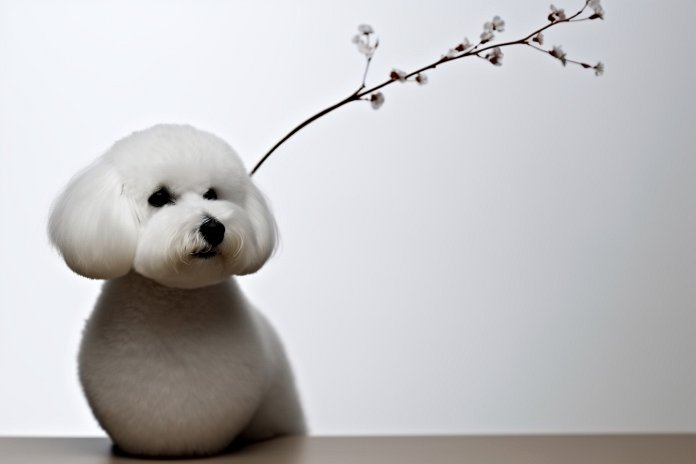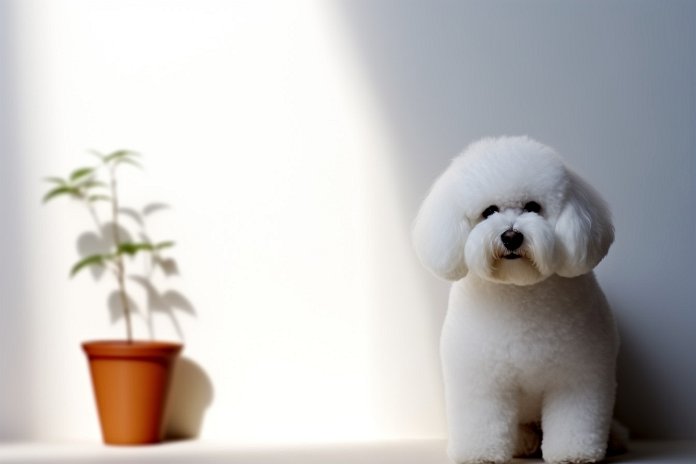
The Bich-poo is a designer dog breed that was created by crossing the Bichon Frise and the Miniature Poodle. This breed inherits the curly and hypoallergenic coats from both of its parents. Despite shedding relatively little, the Bich-poo still requires regular coat upkeep and basic care. They are friendly and lively companions who get along well with children and other animals. Their small size allows them to thrive in both small apartments and larger homes, and they can easily adapt to different environments. However, it’s important to note that due to their tiny size and tendency towards obesity, it’s crucial not to overfeed them.
Ahead, we look at Bich-poo dog breed, its history, personality, pros and cons of owning an Bich-poo, characteristics, and must-see facts. We will also examine how to care for this breed and much more. Prepare for a tail-wagging adventure into the world of Bich-poos!
| Dog Breed | Bich-poo |
| Size | Small |
| Weight | 9-18 lbs (average) |
| Height | 9-15″ (average) |
| Location | Australia |
| Ancestry | Bichon Frise, Miniature Poodle |
| Date of Origin | 1990s |
| Group | Companion |
| Life Expectancy | 11-15 years |
| Price | $1000 – $1500 |
| Family | Canidae |
| Scientific Name | Canis Lupus Familiaris |
📖 Breed History
The history of many hybrid dog breeds, like the Bich-poo, is not well-known due to their modern origins. However, we do have information about the two breeds used to create this designer dog. The Bich-poo is a mix of the Poodle and the Bichon Frise. The Bichon Frise is an ancient breed that originated in the Mediterranean and became popular among Italian nobility in the 1300s. It later gained fame in France and the Canary Islands during the 1500s and 15th-16th centuries, respectively. After losing popularity in the 1800s, efforts were made to revive the breed after World War I. On the other hand, the Poodle was originally bred as a working water retriever and truffle sniffer. It gained popularity in countries like Germany, France, and Spain, and is known for its skills in canine sports and outdoor activities. There are three types of Poodles: standard, miniature, and toy. The Bich-poo combines the best qualities of both parent breeds.

🐕 Bich-poo Appearance
Since it is impossible to predict how much of each parent’s characteristics the dog will inherit, it is difficult to predict exactly what a hybrid breed would look like. We are aware that the dog will exhibit traits from each breed, though. The Bichon Frise is a puffy breed of dog with a thick, unruly coat. Typically, they have all-white faces, a black nose, and dark eyes. Their plumed tails swing over their backs. Typically, their coats will be cropped, either to give them a round look for the show ring or a lower care, shorter cut for indoor companion animals. Poodles have thick, curly fur and a square build. They have long, somewhat stopped muzzles with spherical heads. They will have oval-shaped, dark or amber eyes. These canines come in a choice of solid colors and will have flat toplines. The Bich-poo is often white or apricot in color, with a cute, fluffy coat.
| 👀 Eye Color | Brown |
| 🐽 Nose Color | Black, Brown |
| 🐕 Coat Color | Fawn, White |
⚡ Fun Fact: Bich-poo dogs need a lot of social interaction. They desire to always be with someone or around people. This breed hates being left alone.
🐶 Traits & Temperament of Bich-poo
The designer dog breed excels in intelligence and activity. The Bich-poo will undoubtedly be quite intelligent because both of its parents were highly intelligent dog breeds, particularly Poodles. As a result, they should be rapid learners and toilet training will go well, but they also require cerebral stimulation to prevent destructive behavior. They have a good bit of physical energy as well, which will need to be managed. These dogs can live in practically any home, including one with young children who they will like playing with. But because dogs are little and might damage themselves if dropped or trodden on, make sure your kids know how to manage one. They shouldn’t have any issues getting along with other pets because they are friendly and fun-loving. Because some Poodles might be a little high strung, be cautious to socialize your pet correctly. This hybrid could have separation anxiety and dislike being left alone. They are devoted and, despite their size, they make excellent watchdogs who will warn you if they hear anything out of the ordinary.
🤝 Are Bich-poos Friendly or Aggressive?
Bich-poo dogs are known for their friendly nature, making them a great choice for families. They are comfortable around strangers, children, cats, and other dogs, making them a sociable breed. If you’re looking to expand your furry family or participate in dog meetups, the Bich-poo can be an excellent companion. Additionally, their friendly and gentle demeanor makes them a suitable choice for elderly individuals who are seeking a loving and loyal companion.
This breed is known for being:
- Active
- Playful
- Alert
- Sensitive
- Intelligent
- Affectionate
- Gentle
- Trainable
- Cheerful
- Faithful
- Instinctual
🐩 Bich-poo Care & Maintenance
This breed’s coarse, loose curls will require frequent combing to prevent knots and tangles even though it does not shed much and is thought to be hypoallergenic. When required, give them a bath and a haircut. Every two to four months, they’ll probably require expert grooming. Like other dog breeds, this hybrid breed requires regular dental cleanings and nail trimming in addition to coat maintenance. Every dog needs to have their teeth washed at least once or twice a week, and ideally every day. Regular nail trimming should be done on them, possibly once or twice each month. Less often will be adequate if they naturally deteriorate. If you hear your Bich-poo clicking on the floor as they walk, they need their nails cut. You should also check and clean their ears once a week. Ear infections are a common problem with Bich-poos. To prevent exorbitant veterinarian care costs, get pet health insurance right now. Pet owners may compare insurance policies from reputable firms like FIGO and Nationwide using Wag! Wellness, which is provided by Pet Insurer. With only a few clicks, find your pet’s “pawfect” plan!
Bich-poo dogs are known for being low shedders, which means they don’t lose much hair. This is a natural occurrence in their hair growth cycle. The amount and frequency of hair loss can vary depending on their overall health and the specific breed they belong to. However, it’s important to note that regular bathing is recommended for Bich-poo dogs, typically every 3-4 weeks.
🍖 Food: We recommend 1 cups daily, costing you about $1.00 – $1.20 daily, or roughly $25.00 – $30.00 a month.
🐾 Exercise: Bich-poo dogs have an average exercise need. This breed is satisfied with short walks every weekday and a long ones on weekends.
This dog breed requires to be walked for roughly 8 miles per week, which equates to about 30 minutes of physical activity daily. This consistent moderate exercise regimen will help maintain their physical wellness and significantly contribute to their mental stimulation. Consciously setting aside this time for your furry friend can dramatically enhance their life quality, helping them stay energetic, healthy, and mentally alert.
Did you know: Bich-poo dogs have an average energy level, so if you live a semi-active life, this breed can be a good choice for you.
❤️🩹 Bich-poo Health & Issues
Some of the major concerns for Bich-poo Dog Breed can be:
- Addison’s Disease
- Cushing’s Disease
- Corneal Dystrophy
While minor concerns include:
- Cataracts
- Legg-Calve-Perthes Disease
- Immune Mediated Haemolytic Anaemia (IMHA)
🤧 Important: Is Bich-poo hypoallergenic? Yes.
✨ Bonus: Check out cool, creative, and funny names for Bich-poo.
⚡ Bich-poo Dog Breed Facts
What makes the Bich-poo a great choice for families with young children?
The Bich-poo is a great choice for families with young children because they are friendly, energetic, and love to play. They are known to get along well with children and can handle their active nature.
Is the Bich-poo breed considered a suitable breed for apartment living?
Yes, the Bich-poo breed is considered suitable for apartment living. They are small in size and can adapt well to different environments, including small living spaces like apartments.
How much exercise does a Bich-poo require compared to other breeds?
Bich-poos require a moderate amount of exercise compared to other breeds. They have a fair amount of physical energy that needs to be dealt with, but they do not require excessive exercise like some larger breeds.
Is the Bich-poo breed known for being good with other pets?
Bich-poos are known to be good with other pets. They are amicable and fun-loving, so they should not have any problems getting along with other pets in the household.
What are other low-maintenance dog breeds similar to the Bich-poo?
Some low-maintenance dog breeds similar to the Bich-poo include the Maltese, Shih Tzu, and Yorkshire Terrier. These breeds also have hypoallergenic coats and require minimal grooming.
What are the common health issues that Bich-poos are prone to?
Bich-poos are prone to certain health issues, just like any other dog breed. Some common health issues they may be prone to include allergies, dental problems, and joint issues.
Are Bich-poos known to be easy to train compared to other breeds?
Bich-poos are generally considered easy to train due to their intelligence and willingness to learn. With proper training and socialization, they can quickly pick up commands and potty training should be relatively easy.
Are Bich-poos more prone to separation anxiety compared to other breeds?
Bich-poos can be more prone to separation anxiety compared to other breeds. They are loyal and form strong bonds with their owners, so they may become anxious when left alone for long periods.
Are there any dog breeds similar to the Bich-poo that are suitable for people with allergies?
Yes, there are other dog breeds similar to the Bich-poo that are suitable for people with allergies. Some examples include the Cockapoo, Labradoodle, and Goldendoodle, which are also designer dog breeds.
What sizes of dogs similar to the Bich-poo are best for individuals or families with limited space?
Small sizes of dogs similar to the Bich-poo, such as the Bichon Frise and the Miniature Poodle, are best for individuals or families with limited space. These breeds can adapt well to small living spaces.
Is the Bich-poo breed known to be good with children with special needs?
The Bich-poo breed is known to be good with children in general, but it is important to consider the specific needs and behaviors of children with special needs. It is recommended to introduce the dog to the child in a controlled environment to ensure compatibility.
How does the grooming and shedding needs of the Bich-poo?
In terms of grooming and shedding needs, the Bich-poo requires regular coat maintenance but sheds very little. They have curly and hypoallergenic coats, which means they are a good choice for individuals who are sensitive to allergens. Regular brushing and occasional professional grooming will help keep their coats in good condition.
We use reliable and publicly available data and resources such as AKC and American Canine Registry to ensure that Bich-poo dog breed information is accurate and up to date. If you spot an error, please don’t hesitate to bring it to our attention.